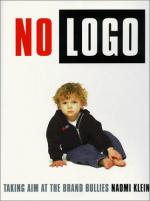|
This section contains 620 words (approx. 2 pages at 400 words per page) |

|
No Logo: Taking Aim at the Brand Bullies Summary & Study Guide Description
No Logo: Taking Aim at the Brand Bullies Summary & Study Guide includes comprehensive information and analysis to help you understand the book. This study guide contains the following sections:
This detailed literature summary also contains Topics for Discussion and a Free Quiz on No Logo: Taking Aim at the Brand Bullies by Naomi Klein.
Consumers have become nothing more than pawns of huge multinational corporations that determine, in large part, what is seen, heard, read and worn. Author Naomi Klein sketches the historical development of this phenomenon, beginning with the shift from selling products manufactured in local factories to the marketing of brands that become identified with culture itself. Indeed, products are made while brands are sold. The shift to brand marketing began with an invasion of cultural space so that billboards, magazines, television and radio commercials, clothing logos, music and cultural events, celebrities, schools and other institutions promoted and idolized the brand in such a way that consumers began to view brands as synonymous with their cultural identities. Corporations became so fixated on their brands that production became secondary. In an effort to maximize funds for brand promotion, therefore, they turned to methods by which they could minimize production costs. This goal was accomplished by moving factories to third-world nations, where labor laws and minimum wages, not to mention benefits packages, were non-existent. The sweatshops of the early twentieth century in America were reborn in urban slums of Asia and Latin America where young women continue to be abused and exploited. The impact on the middle classes in developed nations has been devastating. Workers who could previously plan to be employed for life and enjoy the benefits of a good wage and excellent benefits have found themselves abandoned by the corporations for which their parents worked. Lower paying positions, often on a part-time or temporary basis, are what is left. Retail establishments, employing these part-time and temporary workers, hawk the brands that their employees can hardly afford to purchase. Additional "brandizing" has been accomplished by the advent of "brand-name" stores, such as Nike Town of Disney, all meant to give a brand experience to the children and adults who patronize them. Add to this the theme parks, cruise ships, "branded towns," resorts, and the intrusion of brands into schools and colleges through huge donations in exchange for a privileged position, and one is easily able to see the complete usurpation of cultural space.
Moving forward in a time when de-regulation became public policy, corporations accomplished mergers and buyouts, driving smaller, independent businesses out. These practices have lead to multinational conglomerates which, because of their huge profits, are able to wield inordinate political power through lobbying and campaign contributions, not to mention the threat of "pulling out" if their demands are not met. Specifically within the media, mergers of television networks, news magazines, newspapers and radio stations have resulted in an insidious type of corporate censorship. This has meant that what and how incidents and situations are reported is controlled by executives who protect their lengthy list of subsidiaries and partners. With de-regulation and the ability to control governments of third-world countries, corporations have moved in to privileged positions, not just exploiting the poor, but destroying environments and ecosystems as well.
A backlash has begun that includes "culture jamming," protests, demonstrations, the ejection of corporations from college campuses, and the exposure of corporate "dirty big secrets." As the Internet has developed, so, too have these movements grown, now able to communicate with one another, to coordinate activities, and to undermine corporations through concerted technological efforts to subvert advertising and hack into corporate websites. Executives are subject to protests, pie-throwing, and other abuses as they make public appearances. Celebrities are refusing to hawk product and appear at events sponsored by certain brandized companies. It is in these movements, small but determined, that Klein sees the potential for consumers to reclaim their independence and freedom of choice, to press for human rights globally, and to take back their cultural space and identities.
Read more from the Study Guide
|
This section contains 620 words (approx. 2 pages at 400 words per page) |

|



